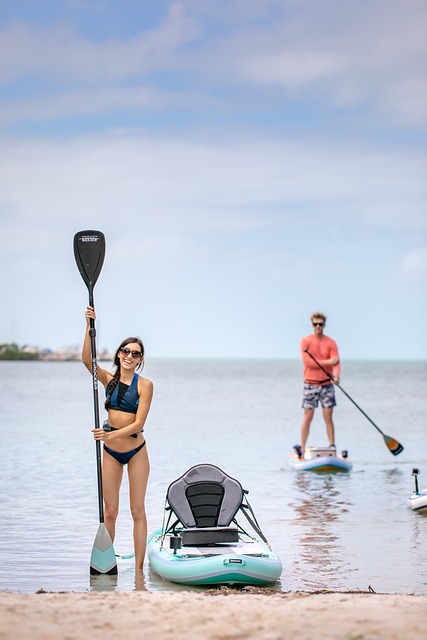Inflatable paddle boards (IPBs) are gaining popularity worldwide for recreational water sports like surfing, stand-up paddle boarding (SUP), and kayaking. IPBs offer portability, affordability, and ease of use, making them accessible to people of all ages and budgets. With high-quality materials, robust valves, and airtight seams, these boards ensure stability in freshwater and saltwater. Their versatile designs cater to various water conditions and skill levels, from beginners to experienced paddlers. Choosing the right IPB involves considering board design, size, shape, and material strength, tailored to individual preferences and paddling goals.
Water sports are gaining global popularity, with inflatable paddle boards (IPBs) at the forefront. IPBs offer a stable and versatile platform suitable for both recreational and competitive activities, catering to a wide range of users. This article explores the benefits and key features that make IPBs a top choice, compares them to traditional paddle boards, and examines their impact on accessibility and safety. We’ll also look at market trends, global adoption, and innovations shaping the future of this exciting sport.
The Rise of Water Sports: A Global Phenomenon

Water sports have experienced a phenomenal rise in popularity across the globe. From calm lakes to wild oceans, recreational activities like surfing, stand-up paddle boarding (SUP), and kayaking have captivated individuals of all ages and backgrounds. One notable trend within this growing sector is the increasing demand for inflatable paddle boards (IPBs). Their portability, affordability, and ease of use make them an attractive option for casual enthusiasts as well as experienced athletes.
The accessibility of IPBs has democratized water sports, enabling more people to enjoy these activities year-round, regardless of their location or budget. As global participation continues to surge, innovative designs and advanced materials further enhance the stability and performance of inflatable boards, ensuring a safe and enjoyable experience for users at every skill level.
Benefits of Inflatable Paddle Boards (IPBs) for Recreational and Competitive Activities

Inflatable Paddle Boards (IPBs) have gained immense popularity across both recreational and competitive water sports circles due to their remarkable benefits. They offer a lightweight yet sturdy alternative to traditional rigid boards, making them highly versatile and accessible for users of varying skill levels and preferences.
One of the key advantages of IPBs is their portability and ease of storage. Their inflatable design allows for compact deflation and packaging, enabling users to easily transport them to any water body or stow them away during off-seasons. This feature is particularly appealing for recreational paddlers who enjoy exploring different locations without the hassle of lugging around bulky equipment. Moreover, IPBs are suitable for various water conditions, from calm lakes to choppy seas, accommodating a wide range of activities such as yoga, fishing, and even surfing in favorable conditions. Their adaptability makes them a stable platform for water sports enthusiasts seeking a fun and engaging outdoor experience.
Key Features Making IPBs a Stable Platform

Inflatable paddle boards (IPBs) offer a range of key features that make them a stable platform for water sports. Firstly, their construction from durable, high-quality materials ensures they can withstand the rigours of both freshwater and saltwater environments. This includes robust valves and airtight seams that prevent leaks, allowing IPBs to maintain their shape and stability even after prolonged use or exposure to rough conditions.
Secondly, the design of IPBs incorporates several stability enhancements. Wider boards provide a broader surface area for better balance and manoeuvrability, while tailored fins and paddle designs offer additional stabilisation in varying water conditions. Moreover, many IPBs come equipped with carrying handles and bungee cord attachment points, enabling users to secure accessories and maintain control during activities like fishing or yoga, enhancing their overall stability and versatility on the water.
– 3.1 Portability and Ease of Setup

One of the key advantages of inflatable paddle boards (IPBs) is their portability and ease of setup. Whether you’re traveling or setting up at a new location, IPBs are designed to be lightweight and compact, making them easy to transport and store. Their modular structure allows for quick assembly with minimal effort, ensuring you spend more time enjoying the water and less time setting up. This convenience makes IPBs an ideal choice for both casual paddlers and those who prioritize flexibility in their outdoor activities.
– 3.2 Durability and Safety Standards

When considering a stable platform for water sports, such as inflatable paddle boarding (IPB), durability and safety standards are paramount. IPBs, known for their versatility and portability, must withstand varying water conditions and user skill levels. Manufacturers prioritize safety by adhering to stringent industry regulations and testing protocols. These include impact resistance standards to protect against punctures and tears, as well as stability tests ensuring the board maintains its shape and balance during use.
The materials used in construction play a crucial role in both durability and safety. High-quality, robust fabrics and reinforced seams prevent leaks and ensure longevity even with extended water exposure. Additionally, grippy decks reduce slippage, enhancing safety for riders of all experience levels. By prioritizing these standards, consumers can enjoy a secure and enjoyable experience on the water while relying on their IPB to perform consistently and reliably.
– 3.3 Versatility in Water Conditions

One of the key advantages of inflatable paddle boards (IPBs) is their remarkable versatility in various water conditions. Whether you’re paddling on calm lakes, navigating gentle rivers, or daring to ride waves at the beach, IPBs offer a stable platform that adapts to different environments. Their durable yet flexible construction allows them to maintain stability and maneuverability across varying water surfaces. This makes them an excellent choice for beginners looking to learn paddle boarding as well as experienced enthusiasts seeking a versatile tool for their aquatic adventures.
The adaptability of IPBs is not just limited to water types; they can also be easily transported and stored, making them a practical option for travel or compact living spaces. Their lightweight design when deflated allows for convenient carrying and packing, ensuring that your paddle boarding experience isn’t restricted by logistics. With an inflatable paddle board, you gain access to a wide range of water-based activities with ease and convenience.
Choosing the Right IPB: Factors to Consider

When choosing the right inflatable paddle board (IPB) for water sports, several factors come into play. First and foremost, consider your skill level and the type of paddling you intend to do. Are you a beginner seeking stability or an experienced paddler looking for speed? IPBs vary in design, with some optimized for surfing waves, others for cruising lakes, and yet others tailored for fitness workouts.
The size and shape of the board are also critical. Longer boards offer more stability but may be less maneuverable, while shorter ones provide better agility and easier turns. Additionally, weight capacity is a safety consideration; ensure the IPB you select can support your weight plus any equipment you plan to carry. Material is another key factor; lighter options are easier to transport and store, while sturdier materials offer better durability for frequent use.
– 4.1 Board Size and Shape for Different Users

Choosing the right inflatable paddle board (IPB) depends on your size and preferred water sport. Generally, longer boards are more stable, ideal for beginners and stand-up paddling, as they offer extra space and better balance. Wider boards also provide increased stability, making them suitable for users looking to carry a passenger or practice yoga. Conversely, shorter, wider boards excel in agility and maneuverability, perfect for experienced paddlers who want to try tricks or explore surf conditions.
Consider your height and weight when selecting an IPB. Larger individuals may require longer, broader boards while smaller users might be more comfortable on a compact, agile model. Additionally, think about the type of activity you plan to engage in: calm water paddling, surfing waves, or whitewater excursions necessitate distinct board shapes and sizes for optimal performance and safety.
– 4.2 Material Composition and Weight Capacity

When considering the best stable platform for water sports, such as inflatable paddle boards (IPBs), material composition and weight capacity are key factors. High-quality IPBs are typically made from durable materials like PVC or EPS foam, ensuring they can withstand rigorous use in various water conditions.
The average inflatable paddle board should support weights up to 250 pounds (113 kg) or more, depending on its size and design. This weight capacity allows for comfortable paddling for both beginners and experienced enthusiasts. Look for IPBs with reinforced stitching and sturdy valves to guarantee a long lifespan even when exposed to constant air inflation and water pressure.
